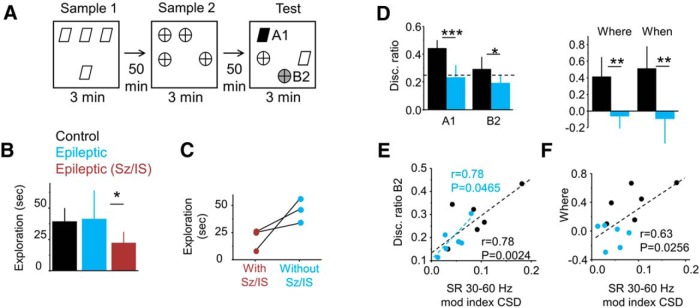Figure 4.
Relationship between slow gamma (30–60 Hz) and performance in the what-where-when episodic-like memory task. A, Schematic representation of the task. The scheme shows object configurations in the sample and test phases (3 min each). The retention interval is 50 min. B, Group data (mean ± SD) of the total exploratory time during the test phase for control rats (n = 6), epileptic rats tested in periods free of epileptiform activities (n = 6), and epileptic rats exhibiting seizures and/or interictal spikes within 2 h of the behavioral task (n = 4; epileptic Sz/IS group), as judged from simultaneous multisite silicon probe recordings. Note the reduced exploratory behavior of rats experiencing epileptiform activities compared with their Sz/IS free epileptic mates. *p < 0.05. C, Data from three rats evaluated in the what-where-when task during periods with and without epileptiform events. Note the different exploratory behavior in the very same animals performing the task with or without signs of epileptiform activities in the dorsal hippocampus. D, Group data (mean ± SD) for the discrimination ratio of object A1 (black) and B2 (green in A), carrying most of the temporal and spatial memory of the exploratory episode. Note epileptic rats discriminate at chance level (0.25). Right plot shows group data for the spatial and temporal memory indices, where and when, respectively. *p < 0.05; **p < 0.005; ***p < 0.0001. Data from six control rats and six epileptic rats free from epileptiform activities. E, Correlation between the slow gamma CSD modulation index and the discrimination index for object B2 (A, green). Significant Pearson correlation was found for both groups (black) and the epileptic group alone (blue). F, Correlation between the slow gamma CSD modulation index and a spatial memory index (where) for both groups (black), but not for either group alone.

